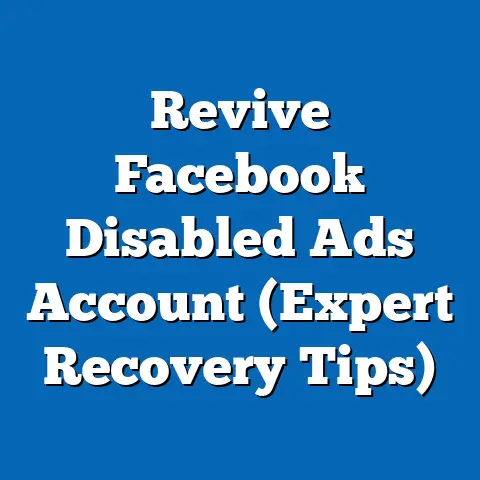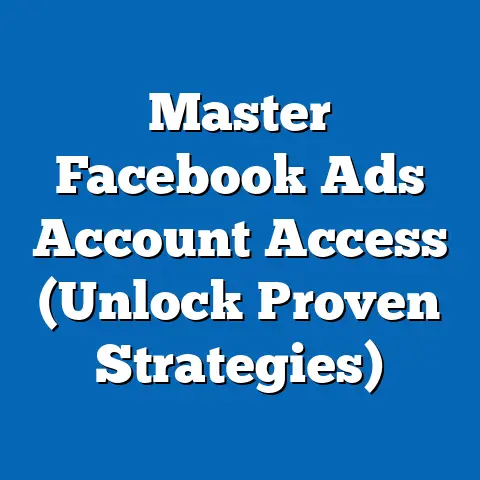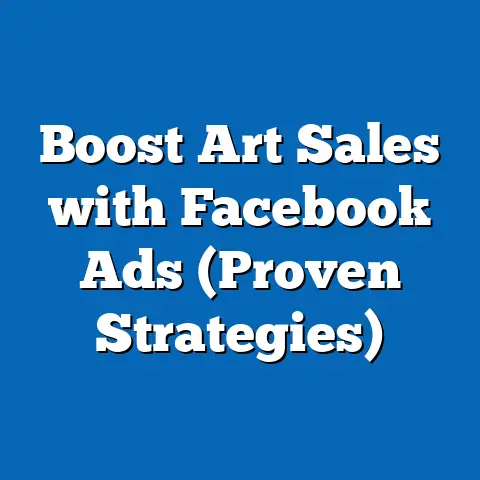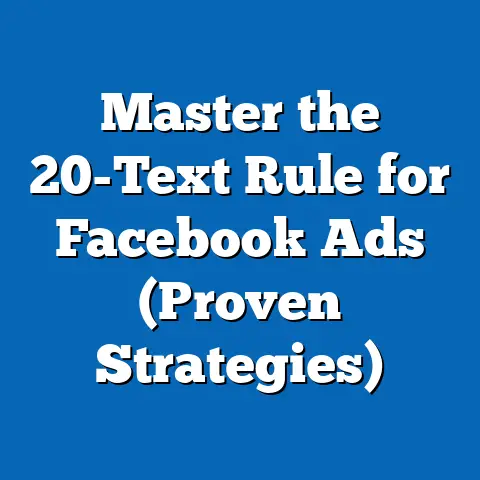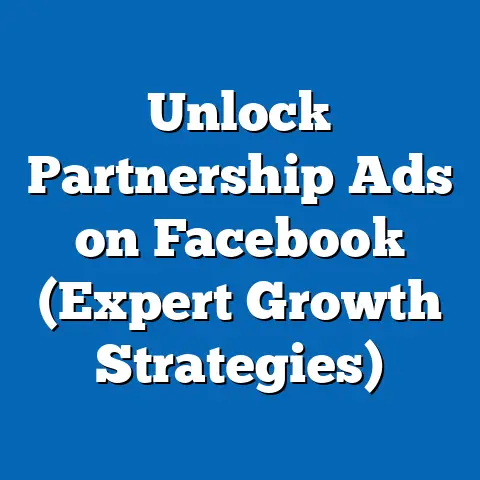Cara Membuat Facebook Ads yang Sukses (Proven Strategies)
Cara Membuat Facebook Ads yang Sukses: Strategi Terbukti untuk Meningkatkan Penjualan
In today’s digital age, where smartphones are practically extensions of our hands and social media dictates trends, the concept of “smart living” has taken on a whole new meaning. We’re constantly seeking ways to optimize our lives, streamline processes, and make informed decisions with the help of technology. And for entrepreneurs and businesses, this translates to leveraging platforms like Facebook to reach their target audience in the most efficient and effective way possible.
Facebook, with its billions of active users, is a goldmine for businesses looking to connect with potential customers. But simply throwing money at ads isn’t enough. You need a strategic approach, a deep understanding of your audience, and a willingness to constantly test and optimize. That’s where mastering Facebook Ads comes in.
1. Understanding Your Audience
Before you even think about crafting an ad, you need to know who you’re talking to. Imagine shouting into a crowded stadium without knowing if anyone speaks your language – that’s what running Facebook Ads without proper audience research is like!
Audience research is the cornerstone of any successful Facebook Ads campaign. It’s about understanding your potential customers – their demographics, interests, behaviors, pain points, and motivations. The more you know, the more targeted and effective your ads will be.
Here’s how I approach audience research:
-
Facebook Insights and Audience Insights: These tools are your best friends. Facebook Insights, accessible from your Facebook Page, provides valuable data about your existing audience – who’s liking your page, what content they engage with, and their demographics. Audience Insights, on the other hand, allows you to explore potential audiences based on interests, behaviors, and demographics. I often use Audience Insights to uncover hidden interests or niche communities that I hadn’t considered before.
- Example: Let’s say you’re selling eco-friendly baby products. Using Audience Insights, you might discover that your target audience is not just interested in “baby products,” but also in “sustainable living,” “organic parenting,” and “zero waste lifestyle.” This opens up new avenues for targeting and messaging.
-
Creating Buyer Personas: Once you’ve gathered data, it’s time to create buyer personas – fictional representations of your ideal customers. Give them names, ages, occupations, hobbies, and even backstories. This helps you humanize your target audience and tailor your ad messages accordingly.
- Example: Meet “Sarah,” a 32-year-old working mom who’s passionate about sustainable living and wants the best for her baby. She’s active on social media, reads parenting blogs, and is willing to spend a little extra on eco-friendly products. Knowing this, you can craft ads that speak directly to Sarah’s values and needs.
-
Segmentation: Not all customers are created equal. Segmentation involves dividing your audience into smaller groups based on shared characteristics. This allows you to create highly targeted ads that resonate with each segment.
- Example: You might segment your audience based on age, location, or purchase history. For example, you could create one ad campaign targeting new parents and another targeting parents with toddlers, each with different messaging and product recommendations.
Facebook Insights and Audience Insights: These tools are your best friends. Facebook Insights, accessible from your Facebook Page, provides valuable data about your existing audience – who’s liking your page, what content they engage with, and their demographics. Audience Insights, on the other hand, allows you to explore potential audiences based on interests, behaviors, and demographics. I often use Audience Insights to uncover hidden interests or niche communities that I hadn’t considered before.
- Example: Let’s say you’re selling eco-friendly baby products. Using Audience Insights, you might discover that your target audience is not just interested in “baby products,” but also in “sustainable living,” “organic parenting,” and “zero waste lifestyle.” This opens up new avenues for targeting and messaging.
Creating Buyer Personas: Once you’ve gathered data, it’s time to create buyer personas – fictional representations of your ideal customers. Give them names, ages, occupations, hobbies, and even backstories. This helps you humanize your target audience and tailor your ad messages accordingly.
- Example: Meet “Sarah,” a 32-year-old working mom who’s passionate about sustainable living and wants the best for her baby. She’s active on social media, reads parenting blogs, and is willing to spend a little extra on eco-friendly products. Knowing this, you can craft ads that speak directly to Sarah’s values and needs.
Segmentation: Not all customers are created equal. Segmentation involves dividing your audience into smaller groups based on shared characteristics. This allows you to create highly targeted ads that resonate with each segment.
- Example: You might segment your audience based on age, location, or purchase history. For example, you could create one ad campaign targeting new parents and another targeting parents with toddlers, each with different messaging and product recommendations.
Key Takeaway: Audience research is an ongoing process. Continuously monitor your ad performance and use the data to refine your targeting and messaging. Don’t be afraid to experiment and test different audiences to find what works best.
2. Crafting Compelling Ad Content
Now that you know who you’re talking to, it’s time to craft ad content that grabs their attention and compels them to take action. This is where creativity and a deep understanding of your audience come into play.
Here are the key elements of successful ad content:
-
Headlines: Your headline is the first thing people see, so it needs to be attention-grabbing and relevant. Use strong verbs, numbers, and questions to pique interest.
- Example: Instead of “Eco-Friendly Baby Products,” try “5 Must-Have Eco-Friendly Baby Products for a Healthy Planet” or “Tired of Harmful Chemicals? Discover Our Eco-Friendly Baby Products!”
-
Descriptions: Your description should expand on the headline and provide more details about your product or service. Highlight the benefits and address any potential concerns.
- Example: “Our eco-friendly baby products are made with organic cotton and non-toxic materials, ensuring the safety and comfort of your little one while protecting the environment. Shop now and enjoy free shipping!”
-
Calls to Action (CTAs): Tell people what you want them to do – “Shop Now,” “Learn More,” “Sign Up,” “Get a Free Quote,” etc. Use clear and concise language and make your CTA button prominent.
- Pro Tip: Test different CTAs to see which performs best. Sometimes a simple change can make a big difference.
-
Engaging Visuals: High-quality images and videos are essential for capturing attention in a crowded newsfeed. Use visuals that are relevant to your product or service and that resonate with your target audience.
- Example: For eco-friendly baby products, use images of happy babies playing in nature or parents using your products in a stylish and eco-conscious home.
-
Storytelling: People connect with stories. Use your ads to tell a story about your brand, your products, or your customers. This can create an emotional connection and make your ads more memorable.
- Example: Share a story about how your company was founded with a mission to provide safe and sustainable products for babies. Or feature a customer testimonial about how your products have made a positive impact on their family.
Headlines: Your headline is the first thing people see, so it needs to be attention-grabbing and relevant. Use strong verbs, numbers, and questions to pique interest.
- Example: Instead of “Eco-Friendly Baby Products,” try “5 Must-Have Eco-Friendly Baby Products for a Healthy Planet” or “Tired of Harmful Chemicals? Discover Our Eco-Friendly Baby Products!”
Descriptions: Your description should expand on the headline and provide more details about your product or service. Highlight the benefits and address any potential concerns.
- Example: “Our eco-friendly baby products are made with organic cotton and non-toxic materials, ensuring the safety and comfort of your little one while protecting the environment. Shop now and enjoy free shipping!”
Calls to Action (CTAs): Tell people what you want them to do – “Shop Now,” “Learn More,” “Sign Up,” “Get a Free Quote,” etc. Use clear and concise language and make your CTA button prominent.
- Pro Tip: Test different CTAs to see which performs best. Sometimes a simple change can make a big difference.
Engaging Visuals: High-quality images and videos are essential for capturing attention in a crowded newsfeed. Use visuals that are relevant to your product or service and that resonate with your target audience.
- Example: For eco-friendly baby products, use images of happy babies playing in nature or parents using your products in a stylish and eco-conscious home.
Storytelling: People connect with stories. Use your ads to tell a story about your brand, your products, or your customers. This can create an emotional connection and make your ads more memorable.
- Example: Share a story about how your company was founded with a mission to provide safe and sustainable products for babies. Or feature a customer testimonial about how your products have made a positive impact on their family.
Real-World Examples:
- Dove: Their “Real Beauty” campaign is a classic example of storytelling that resonates with audiences. They use ads to celebrate diverse body types and challenge traditional beauty standards.
- Airbnb: They often feature user-generated content in their ads, showcasing unique travel experiences and creating a sense of community.
- Nike: They use powerful visuals and inspiring stories to motivate people to achieve their fitness goals.
Key Takeaway: Compelling ad content is about understanding your audience’s needs and desires and crafting messages that resonate with them. Use strong headlines, engaging visuals, and storytelling to capture attention and drive action.
3. Choosing the Right Ad Format
Facebook offers a variety of ad formats to choose from, each with its own strengths and weaknesses. Selecting the right format is crucial for maximizing your campaign’s effectiveness.
Here’s a breakdown of the most common ad formats:
-
Single Image Ads: These are simple but effective for showcasing a product or service with a compelling image and concise text.
- Best For: Product announcements, brand awareness, and simple promotions.
-
Single Video Ads: Video is highly engaging and can be used to tell a story, demonstrate a product, or share a testimonial.
- Best For: Product demos, brand storytelling, and capturing attention in a crowded newsfeed.
-
Carousel Ads: These allow you to showcase multiple images or videos in a single ad, each with its own headline, description, and link.
- Best For: Showcasing multiple products, highlighting different features of a product, or telling a sequential story.
-
Slideshow Ads: These are similar to video ads but use a series of static images instead of a video. They’re a great option for creating engaging content without the cost of video production.
- Best For: Creating visually appealing content on a budget, showcasing a product in different settings, or telling a simple story.
-
Collection Ads: These are designed for mobile commerce and allow users to browse and purchase products directly from the ad.
- Best For: E-commerce businesses looking to drive sales directly from Facebook.
-
Instant Experience Ads: These are full-screen, mobile-optimized ads that load instantly when someone clicks on them. They can include images, videos, carousels, and text.
- Best For: Creating immersive brand experiences, showcasing a wide range of products, or telling a detailed story.
Single Image Ads: These are simple but effective for showcasing a product or service with a compelling image and concise text.
- Best For: Product announcements, brand awareness, and simple promotions.
Single Video Ads: Video is highly engaging and can be used to tell a story, demonstrate a product, or share a testimonial.
- Best For: Product demos, brand storytelling, and capturing attention in a crowded newsfeed.
Carousel Ads: These allow you to showcase multiple images or videos in a single ad, each with its own headline, description, and link.
- Best For: Showcasing multiple products, highlighting different features of a product, or telling a sequential story.
Slideshow Ads: These are similar to video ads but use a series of static images instead of a video. They’re a great option for creating engaging content without the cost of video production.
- Best For: Creating visually appealing content on a budget, showcasing a product in different settings, or telling a simple story.
Collection Ads: These are designed for mobile commerce and allow users to browse and purchase products directly from the ad.
- Best For: E-commerce businesses looking to drive sales directly from Facebook.
Instant Experience Ads: These are full-screen, mobile-optimized ads that load instantly when someone clicks on them. They can include images, videos, carousels, and text.
- Best For: Creating immersive brand experiences, showcasing a wide range of products, or telling a detailed story.
A/B Testing:
The best way to determine which ad format performs best for your specific goals is to A/B test different options. Create multiple ad sets, each with a different ad format, and track their performance. This will help you identify which formats resonate most with your audience and drive the best results.
Key Takeaway: Choose the ad format that best aligns with your campaign objectives and audience preferences. Don’t be afraid to experiment and A/B test different options to find what works best.
4. Setting a Budget and Bidding Strategy
Setting a budget and choosing the right bidding strategy are crucial for maximizing your ROI on Facebook Ads. You need to find the sweet spot between spending enough to reach your target audience and avoiding overspending on ineffective ads.
Here’s how I approach budgeting and bidding:
-
Budget Types: Facebook offers two main budget types:
- Daily Budget: This sets the average amount you’re willing to spend each day. Facebook will try to spend this amount each day, but it may fluctuate slightly.
- Lifetime Budget: This sets the total amount you’re willing to spend over the entire duration of your campaign. Facebook will optimize your spending to ensure you don’t exceed your budget.
-
Choosing a Budget: The right budget depends on your business goals, target audience size, and ad relevance. Start with a small budget and gradually increase it as you see positive results.
- Pro Tip: Use Facebook’s budget recommendations as a starting point, but don’t be afraid to adjust based on your own data and experience.
-
Bidding Strategies: Facebook offers several bidding strategies to choose from:
- Lowest Cost: Facebook will try to get you the most results for your budget, without regard to cost per result.
- Cost Cap: You set a maximum cost you’re willing to pay for each result. Facebook will try to stay below this cost, but it may not always be possible.
- Target Cost: You set a target cost you’re willing to pay for each result. Facebook will try to get you results at this cost, but it may fluctuate.
- Value Optimization: (For e-commerce) Facebook will target people who are most likely to make a purchase and spend the most money.
-
Choosing a Bidding Strategy: The best bidding strategy depends on your campaign objectives and budget. If you’re new to Facebook Ads, I recommend starting with “Lowest Cost” to get a feel for the platform. As you gain more experience, you can experiment with other strategies.
Budget Types: Facebook offers two main budget types:
- Daily Budget: This sets the average amount you’re willing to spend each day. Facebook will try to spend this amount each day, but it may fluctuate slightly.
- Lifetime Budget: This sets the total amount you’re willing to spend over the entire duration of your campaign. Facebook will optimize your spending to ensure you don’t exceed your budget.
Choosing a Budget: The right budget depends on your business goals, target audience size, and ad relevance. Start with a small budget and gradually increase it as you see positive results.
- Pro Tip: Use Facebook’s budget recommendations as a starting point, but don’t be afraid to adjust based on your own data and experience.
Bidding Strategies: Facebook offers several bidding strategies to choose from:
- Lowest Cost: Facebook will try to get you the most results for your budget, without regard to cost per result.
- Cost Cap: You set a maximum cost you’re willing to pay for each result. Facebook will try to stay below this cost, but it may not always be possible.
- Target Cost: You set a target cost you’re willing to pay for each result. Facebook will try to get you results at this cost, but it may fluctuate.
- Value Optimization: (For e-commerce) Facebook will target people who are most likely to make a purchase and spend the most money.
Choosing a Bidding Strategy: The best bidding strategy depends on your campaign objectives and budget. If you’re new to Facebook Ads, I recommend starting with “Lowest Cost” to get a feel for the platform. As you gain more experience, you can experiment with other strategies.
Analyzing Ad Performance:
Regularly monitor your ad performance metrics, such as cost per click (CPC), cost per impression (CPM), and cost per conversion (CPA), to see how your budget is being spent and how effective your bidding strategy is.
Key Takeaway: Setting a realistic budget and choosing the right bidding strategy are essential for maximizing your ROI on Facebook Ads. Continuously monitor your ad performance and adjust your budget and bidding strategy as needed.
5. Monitoring and Analyzing Ad Performance
Running Facebook Ads is not a “set it and forget it” activity. It requires continuous monitoring and analysis to ensure you’re getting the best possible results.
Here are the key tools and metrics to monitor:
- Facebook Ads Manager: This is your central hub for managing and analyzing your Facebook Ads campaigns. It provides a wealth of data on your ad performance, including reach, impressions, clicks, conversions, and cost per result.
-
Key Metrics:
- Reach: The number of unique people who saw your ad.
- Impressions: The number of times your ad was displayed.
- Click-Through Rate (CTR): The percentage of people who clicked on your ad after seeing it. A high CTR indicates that your ad is relevant and engaging.
- Cost Per Click (CPC): The average cost you paid for each click on your ad.
- Cost Per Impression (CPM): The average cost you paid for 1,000 impressions of your ad.
- Conversion Rate: The percentage of people who completed a desired action (e.g., made a purchase, signed up for a newsletter) after clicking on your ad.
- Cost Per Conversion (CPA): The average cost you paid for each conversion.
- Return on Ad Spend (ROAS): The amount of revenue you generated for every dollar you spent on advertising.
-
Interpreting Data: Don’t just look at the numbers – try to understand what they mean. For example, a low CTR might indicate that your ad copy or visuals are not compelling enough. A high CPA might indicate that your targeting is too broad or that your landing page is not optimized for conversions.
-
Ongoing Testing and Optimization: Use the data you gather to continuously test and optimize your ads. Try different headlines, descriptions, visuals, CTAs, and targeting options. The more you test, the better you’ll understand what works best for your audience.
- Pro Tip: Use Facebook’s A/B testing feature to easily compare different versions of your ads.
Key Metrics:
- Reach: The number of unique people who saw your ad.
- Impressions: The number of times your ad was displayed.
- Click-Through Rate (CTR): The percentage of people who clicked on your ad after seeing it. A high CTR indicates that your ad is relevant and engaging.
- Cost Per Click (CPC): The average cost you paid for each click on your ad.
- Cost Per Impression (CPM): The average cost you paid for 1,000 impressions of your ad.
- Conversion Rate: The percentage of people who completed a desired action (e.g., made a purchase, signed up for a newsletter) after clicking on your ad.
- Cost Per Conversion (CPA): The average cost you paid for each conversion.
- Return on Ad Spend (ROAS): The amount of revenue you generated for every dollar you spent on advertising.
Interpreting Data: Don’t just look at the numbers – try to understand what they mean. For example, a low CTR might indicate that your ad copy or visuals are not compelling enough. A high CPA might indicate that your targeting is too broad or that your landing page is not optimized for conversions.
Ongoing Testing and Optimization: Use the data you gather to continuously test and optimize your ads. Try different headlines, descriptions, visuals, CTAs, and targeting options. The more you test, the better you’ll understand what works best for your audience.
- Pro Tip: Use Facebook’s A/B testing feature to easily compare different versions of your ads.
Key Takeaway: Monitoring and analyzing your ad performance is crucial for sustained success. Use the data you gather to continuously test and optimize your ads and improve your ROI.
Conclusion
Creating successful Facebook Ads is a journey, not a destination. It requires a deep understanding of your audience, compelling content, the right ad format, a well-defined budget, and continuous monitoring and analysis.
By applying the proven strategies I’ve shared in this article, you can unlock the power of Facebook Ads and achieve your business goals. Remember to:
- Understand Your Audience: Know their demographics, interests, and behaviors.
- Craft Compelling Content: Use strong headlines, engaging visuals, and storytelling.
- Choose the Right Ad Format: Select the format that best aligns with your campaign objectives.
- Set a Budget and Bidding Strategy: Find the sweet spot between spending enough and avoiding overspending.
- Monitor and Analyze Ad Performance: Use the data you gather to continuously test and optimize your ads.
I encourage you to apply these strategies in your own Facebook Ad campaigns and see the results for yourself. With a little effort and a lot of data-driven decision-making, you can transform your business outcomes and contribute to a smarter approach to living and working in a digital-first world. Good luck, and happy advertising!


